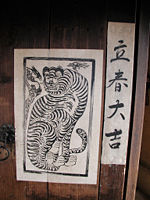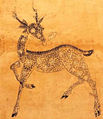- Minhwa
-
Minhwa 
This minhwa depicts a tiger, one of the popular subjects for Korean.Korean name Hangul 민화 Hanja 民畵 Revised Romanization Minhwa McCune–Reischauer Minhwa Minhwa art refers to the Korean folk art that consists of paintings of mythical figures and other objects in a specific plain, straightforward and naive style.
Literally "painting of the people" or "popular painting". This type of painting was often the work of anonymous craftsmen who faithfully adhered to the styles, canons and genres inherited from the past. Minhwa also involved a magical dimension. They were believed to possess beneficial virtues and to protect the owner and his family from evil forces. They feature popular themes such as cranes, rocks, water, clouds, the sun, moon, pine-trees, tortoises, insects and flowers.
Minhwa art developed into its present form in the seventeenth century. The artists were common people who went from place to place, often following festivals, where they would paint for the locals, fulfilling their commissions on the spot. Important stages in life were also marked by the painting of a minhwa picture. Both common people and nobles would commission these artists.
The paintings worked on a number of levels. They show figures from folk mythology and legends, symbols of happiness, wealth and health, and scenes of every-day life. The most common figures were animals that represented power, such as the tiger, or providential circumstances, such as carp, which represent success. The paintings were done on paper and on canvas.
After a decline during the colonial rule, the art form experienced a short boom until laid low by the Korean War. In the 1980s, though, there was a revival of Minhwa, the interest and popularity of which persists to this day.
Literature
- Korean Tiger: An Exhibition of Korean Folk Painting; To Commemorate the Dedication of the Olympic stadium; Seoul, Sept.29-Oct.14, 1984. Zayong Zo [editor]. Seoul: Emilie Museum, 1984.
- Yoon, Yul Soo, 2005, Minhwa, designhouse.
Gallery
-
Ssanghak pandodo, literally "picture of two cranes and peaches in Sungyeong", paradise of Korean Taoism
External links
Categories:
Wikimedia Foundation. 2010.











